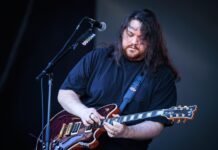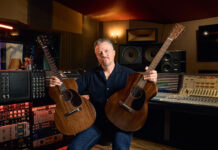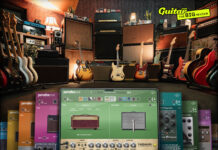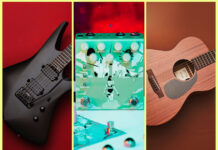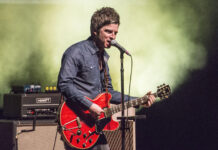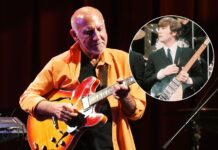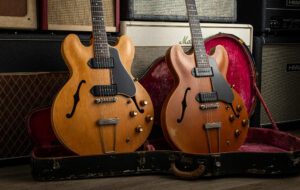
How to buy a vintage Gibson thinline
Gibson’s ES series is almost as old as the company itself. Originally used to distinguish guitars that were designed to be played in the conventional manner rather that flat on the lap in the Hawaiian style, the ES designation simply meant ‘Electric Spanish’. But when contemporary pop, rock and blues players think of Gibson’s ES guitars, they are usually thinking of thinline models rather than deep-bodied jazzboxes.
READ MORE: How to buy a vintage Fender Strat
Gibson’s reputation as a premium guitar manufacturer was established by its traditional archtops. The company transitioned to making superb solidbodies within an impressively short timeframe but, in meeting customer demand for sustain and feedback-resistance while staying true to the Gibson aesthetic, ES thinlines are some of the company’s greatest designs. There are plenty to choose from, including outliers such as the Byrdland, ES-350 and various ES-125 models, but here we’ll confine our focus to the big hitters in Gibson’s thinline range.
ES-225
Introduced in 1955, the ES-225T was Gibson’s first thinline and could be regarded as a transitional model connecting the deep jazzboxes and the thinline double cutaways. The first models had a single, centrally mounted P-90, and in 1956 Gibson launched a two pickup version.
Featuring a hollow laminated-maple body with a bound rosewood fretboard, there were two colour options – sunburst and natural. All the models had a T suffix for thinline, with a D added for double pickups and N for a natural finish. So, an ES-225TN would be a single pickup version with a natural finish and the ES-225TDN would be a natural finish with two pickups. The sunburst evolved from tobacco to more of a reddish three-tone ’burst towards the late 1950s.
Some may be put off by the tailpiece – an elongated version of the type used on the earliest Les Pauls. Don’t be, because the strings are top-wrapped, as intended, and it’s a fantastic-sounding piece of hardware. Models from 1959, the final year of production, feature Gibson’s smaller trapeze tailpiece, along with an ABR-1 mounted on a floating rosewood base. The single-pickup models from that year often have a rosewood bridge, which offers less vibrance and sustain.
ES-225s with the earlier bridge arrangement may surprise you with their feedback resistance and ample sustain, thanks in no small part to a thick maple block glued under the top between the braces. When you consider you’re getting the same hardware, electronics and neck profile as a pre-1956 Les Paul Goldtop for a fraction of the price, you might conclude that the ES-225 remains a bit of a bargain. But always check that the parts haven’t been pilfered to restore or fake more desirable Gibson models.
ES-335
It’s not the fanciest of Gibson’s thinline doublecuts, and it wasn’t the most expensive in the range, but the ES-335 has proved to be the most popular and collectable. Gibson came up with some novel ideas during the Ted McCarty era, with the korina trio and reverse Firebird models being the most radical from an aesthetic perspective. But, in many ways, the ES-335 was the most revolutionary of the lot. Indeed, many players consider the ES-335 to be the greatest electric guitar design of all time.
Familiarity has blunted the impact that the ES-335 must have made in 1958. Gibson successfully adapted its traditional archtop aesthetic using a double-cutaway body outline with a neck set low into the body like the Les Paul models. But the most innovative feature was only visible through the f-holes.
It could be said that Gibson had revisited Les Paul’s original ‘log’ guitar concept, with a solid block running through the centre of the body and hollow wings. If so, Gibson refined his idea almost beyond recognition, with a solid maple block between the neck and tail ends that was glued to the bent laminate sides closely coupled to the front and back with kerfed spruce braces.
With the block being so narrow relative to the body, a significant area of air space was retained and the front and back were still able to flex. Gibson had created a true semi-solid design, combining some of the sustain and feedback resistance of a Les Paul with airiness and acoustic qualities of a hollowbody. The ES-345 and ES-355 models we’ll be discussing shortly were constructed in exactly the same way.
Having got the neck angle wrong on the first Goldtop Les Pauls, and then rectifying the issue, Gibson repeated its mistake with the earliest ES-335s. Once again, the necks were set too shallow and the ABR-1 bridges had to be set almost flat to the body – or even shaved down, making them prone to bending under string pressure – to achieve a playable setup.
The first ES-335s also had unbound rosewood fretboards, celluloid dot markers and a completely solid centre block that meant all the controls had to be installed through the f-hole. The necks were pretty chunky and the only finish options were natural and sunburst.
Gibson also used three-ply laminations on the earliest ES-335s, resulting in thinner plates and enhanced body resonance. The apparent downside is that cracks and warps could develop and Gibson apparently changed to four-ply in late 1958/early ’59. The 1959 model had a slightly slimmed down but pleasantly full neck profile, and retained the dots and long pickguard that extended beyond the bridge. However, Gibson had addressed the neck angle issue and started binding the ’board. Cherry was also offered as a finish option.
These specifications lasted until late 1960, when Gibson introduced a much slimmer neck profile and its new reflector knobs. The natural finish ceased to be an option in 1961, which coincided with Gibson stamping the serial numbers onto the headstock. Metal strap buttons replaced white plastic ones and a white plastic switch tip replaced the amber Catalin type. The ES-335’s pickguard was also shortened around this time.
1962 saw some big changes, with blocks replacing the dots, the ABR-1 bridge acquiring a saddle retaining wire and the rounded ‘Micky Mouse’ ears gradually giving way to a more pointed shape. Necks began fattening up again and the bridge saddles transitioned from nickel-plated brass to nylon. The most significant change was the move to patent number decals on the undersides of the pickups. It happened gradually, and it’s not unheard of for guitars from this era to feature a mismatched pair with one PAF and one patent number pickup.
In 1965, Gibson swapped the stop tailpiece for a trapeze and began plating the metal parts in chrome rather than nickel. The nut width narrowed from 1 11/16” to 1 5/8”, and then 1 9/16”. Many 1965 guitars have a mashup of features because Gibson would always use up older parts.
Indian rosewood fretboards replaced Brazilian rosewood in 1966, when the headstock angle changed from 17 to 14 degrees. The pickguard bevel angle changed too and the ‘crown’ inlay shifted lower down the headstock. Witch hat knobs arrived in 1967 and in 1968, the nut width reverted to 1 11/16”. During 1969 the f-holes became wider and Gibson began reinforcing the headstock with a volute, although accounts differ and some view this as a 1970 feature.
Gibson even made a 12-string version of the ES-335 between 1965 and 1969. Besides a slightly different tailpiece and an elongated headstock with a split-diamond inlay, there was very little difference between the ES-335TD and ES-335TD-12 during that era.
ES-345 & ES-355
Most of the changes that occurred to the ES-335 also apply to the ES-345 and ES-355. Introduced in 1959, the ES-345 is a fancier version of the ES-335, with white/black/white body binding, double parallelogram fretboard markers and gold-plated hardware. But the most significant points of difference are electronic.
Sharing the ES-335’s pickup compliment and controls, the ES-345 also boasted the dubious benefits of the Varitone circuit. Some regard it as a tone sucker and most players prefer the ES-335’s simpler arrangement, although it must be said that a handful of blues legends put it to good use over the years.
In its basic form, the Varitone has a chickenhead knob tied to a six-way switch. This controls a network of five capacitors connected to five 10M resistors and a choke. You get a bypass position plus five notch filters providing scoops at five preset frequencies – almost like a wah pedal with five fixed frequency steps that cut rather than boost.
1 of 10
Also introduced in 1959, the ES-355 was Gibson’s top of the line semi-solid thinline. It is to the ES-335 what the Les Paul Custom is to the Les Paul Standard, with a headstock featuring multi-layer binding and a fancier inlay, plus an ebony fretboard with pearl blocks and gold hardware. The body binding acquired extra layers too.
A stereo Varitone was an optional upgrade for the ES-345. Stereo came as standard on the ES-355 – with mono wiring as an option. Plenty of manufacturers were chasing the stereo dragon around that time, despite the fact that very few players were interested and it was arguably fairly pointless. Converting a stereo ES-355 to mono is possible, but it’s not straightforward.
In 1961 the ES-355 was lumbered with Gibson’s sideways vibrato but happily some were also fitted with the Lyre Vibrola or a gold-plated Bigsby. All three vibratos were options for the ES-335 and ES-345 too. When any of these models were ordered with a Bigsby from the factory, Gibson would cover the stop tailpiece holes with a black plastic plate etched with the words ‘custom made’.
In 1963, Gibson switched the tuners to ribbed, metal-key Klusons and a walnut finish became available for all three ES doublecuts. Of all the Gibson double-cutaway thinlines, the ES-355 is probably the least popular and collectable despite its associations with the likes of BB King, Johnny Marr, Bernard Butler, Noel Gallagher and others.
Johnny Marr with The Smiths. Image: Pete Cronin / Redferns / Getty Images
ES-330
Although outwardly similar to Gibson’s other thinline doublecuts, the ES-330 is a very different beast. The body design is fully hollow, the pickups are P-90 single-coils and until 1968, the neck joined the body at the 16th rather than the 19th fret.
With a bound neck, trapeze tailpiece, ABR-1 bridge and pearl headstock logo, the ES-330 was more like a successor to the ES-225 than it was the more downmarket ES-125TC and ES-125TCD. The neck is set low into the body, like an ES-335, enabling the fixed bridge to be mounted onto the body with threaded posts. Several of the ES-330’s other features mirrored those of the ES-335, with blocks replacing dots by the middle of 1962 and the ‘Mickey Mouse’ ears becoming more pointed around the same time. The original black plastic pickup covers also changed to nickel plated metal that year, with reports of metal-coated plastic covers during the transition.
1964 ES-330 models had an orange label under the bass side f-hole and, from 1965, Gibson fitted chrome-plated hardware rather than nickel. ES-330 neck profiles also followed ES-335 trends, and witch hat knobs appeared in 1967 and a narrower pickguard bevel in 1968.
Sunburst and cherry finishes are the most common, with the sought after natural finish on early examples and Sparkling Burgundy being offered between 1967 and 1969. Walnut was introduced in 1968 and there were also Pelham Blue and black examples – with the latter being particularly sought-after.
No longer regarded as a budget ES-335, the ES-330 has never been more popular and, in the modern low-volume gigging environment, the ES-330’s tendency to feed back has become a controllable asset rather than a practical challenge. With its warm and distinctly hollow woodiness, it’s a favourite model of Barrie Cadogan and Bernard Butler, who owns one of those ultra-rare black examples.
1 of 20
Trini Lopez
Trini Lopez was a big star during the 1960s who had hit records, starred on the silver screen and was even signed by Frank Sinatra. However, many of us know Lopez’s signature Gibson as the guitar of choice and studio secret weapon for Foo Fighters main-man Dave Grohl. It would even go on to form the basis of Grohl’s own signature Gibson ES-335.
Lopez actually had two signature models with Gibson, the deep-bodied Trini Lopez Custom/Deluxe and the thinline Trini Lopez Standard. for the Standard model, Lopez specified an ES-335 body with diamond-shaped soundholes, and a neck with a non-reverse Firebird headstock and split diamond fretboard markers. Despite being introduced in 1964, when ES-335s still came with stop tailpieces as standard, the Trini Lopez Standard features a trapeze complete with the type of name plaque that was typical on Gibson’s signature jazz models.
Colour options were cherry, Sparkling Burgundy and Pelham Blue, and the electronics were identical to the ES-335s of that era, with patent number pickups. Recently reissued by Gibson, the Trini Lopez Standard is more popular than ever but relatively few were made before the initial production run ceased in 1971 and, though you can find them, price tags on original models are shooting up. Good luck with the search!
Head to Guitar.com for plenty more on vintage Gibson instruments.
The post How to buy a vintage Gibson thinline appeared first on Guitar.com | All Things Guitar.
Source: www.guitar-bass.net

